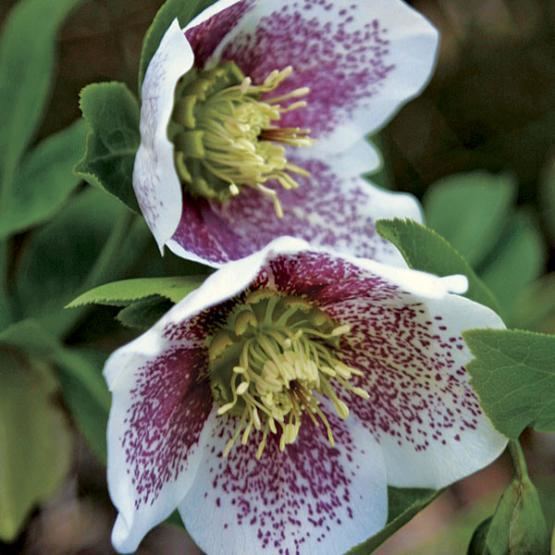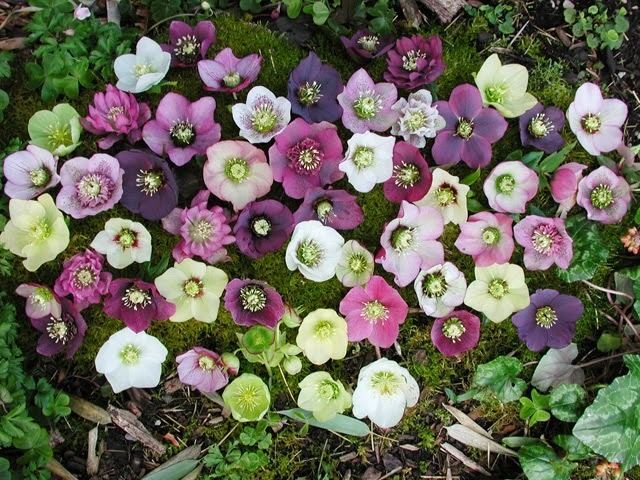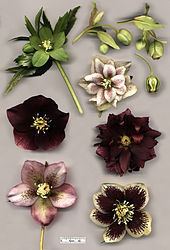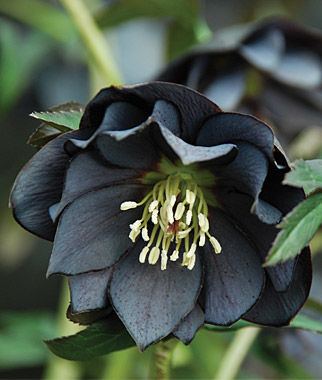Scientific name Helleborus Rank Genus | ||
 | ||
Lower classifications | ||
How to grow hellebores
Commonly known as hellebores /ˈhɛlᵻbɔərz/, the Eurasian genus Helleborus consists of approximately 20 species of herbaceous or evergreen perennial flowering plants in the family Ranunculaceae, within which it gave its name to the tribe of Helleboreae. The scientific name Helleborus derives from the Greek name for H. orientalis, ἑλλέβορος helléboros, from elein "to injure" and βορά borá "food". Many species are poisonous. Despite names such as "winter rose", "Christmas rose" and "Lenten rose", hellebores are not closely related to the rose family (Rosaceae).
Contents
- How to grow hellebores
- Tips on planting and caring for hellebores and protecting your lawn from the chafer beetle
- Distribution and description
- Horticulture
- Species and subspecies
- Caulescent species
- Acaulescent stemless species
- Hellebore hybrids
- Interspecific hybrids
- Medicinal uses and toxicity
- In folklore
- References

Tips on planting and caring for hellebores and protecting your lawn from the chafer beetle
Distribution and description

Various species of this genus originated in Europe and Asia. The greatest concentration of species occurs in the Balkans. One atypical species (H. thibetanus) comes from western China; another atypical species (H. vesicarius) inhabits a small area on the border between Turkey and Syria.

The flowers have five petal-like sepals surrounding a ring of small, cup-like nectaries which are actually "petals" modified to hold nectar. The sepals do not fall as petals would, but remain on the plant, sometimes for many months. Recent research in Spain suggests that the persistence of the sepals contributes to the development of the seeds (Herrera 2005).
Horticulture

Hellebores are widely grown in USDA Zone 5a to 8b gardens for decorative purposes. They are particularly valued by gardeners for their winter and early spring flowering period; the plants are surprisingly frost-resistant and many are evergreen. Also of value is their shade tolerance. Many species of hellebore have green or greenish-purple flowers and are of limited garden value, although Corsican hellebore (H. argutifolius), a robust plant with pale green, cup-shaped flowers and attractive leathery foliage, is widely grown. So is the 'stinking hellebore' or setterwort (H. foetidus), which has drooping clusters of small, pale green, bell-shaped flowers, often edged with maroon, which contrasts with its dark evergreen foliage. H. foetidus 'Wester Flisk', with red-flushed flowers and flower stalks, is becoming popular, as are more recent selections with golden-yellow foliage.

The so-called Christmas rose (H. niger), a traditional cottage garden favourite, bears its pure white flowers (which often age to pink) in the depths of winter; large-flowered cultivars are available, as are pink-flowered and double-flowered selections.

The most popular hellebores for garden use, however, are undoubtedly H. orientalis and its colourful hybrids (H. × hybridus). In the northern hemisphere, they flower in early spring, around the period of Lent, and are often known as Lenten hellebores, oriental hellebores, or Lenten roses. They are excellent for bringing early colour to shady herbaceous borders and areas between deciduous shrubs and under trees.
Species and subspecies
22 species are recognised and divided into 6 sections.
Caulescent species
These four species have leaves on their flowering stems (in H. vesicarius the stems die back each year; it also has basal leaves).
Acaulescent (stemless) species
These species have basal leaves. They have no true leaves on their flower stalks (although there are leafy bracts where the flower stalks branch).
Other species names (now considered invalid) may be encountered in older literature, including H. hyemalis, H. polychromus, H. ranunculinus, H. trifolius.
Hellebore hybrids
Hybridising (deliberate and accidental) between H. orientalis and several other closely related species and subspecies has vastly improved the colour-range of the flowers, which now extends from slate grey, near-black, deep purple and plum, through rich red and pinks to yellow, white and green. The outer surface of the sepals is often green-tinged, and as the flower ages it usually becomes greener inside and out; individual flowers often remain on the plant for a month or more. The inner surface of each sepal may be marked with veins, or dotted or blotched with pink, red or purple. "Picotee" flowers, whose pale-coloured sepals have narrow margins of a darker colour, are much sought-after, as are those with dark nectaries which contrast with the outer sepals.
Recent breeding programmes have also created double-flowered and anemone-centred plants. Ironically, doing this is actually reversing the evolutionary process in which hellebores' true petals had been modified into nectaries; it is usually these nectaries which become the extra petals in double, semi-double and anemone-centred flowers. Double hellebores provide a very intesting variation to the standard hellebore. They are generally easy to maintain and share the same planting conditions as the standard hellebore.
Semi-double flowers have one or two extra rows of petals; doubles have more. Their inner petals are generally very like the outer ones in colour and patterning. They are often of a similar length and shape, though they may be slightly shorter and narrower, and some are attractively waved or ruffled. By contrast, anemone-centred flowers have, cupped within the five normal outer petals, a ring of much shorter, more curved extra petals (sometimes trumpet-shaped, intermediate in appearance between petals and nectaries), which may be a different colour from the outer petals. These short, extra petals (sometimes known as "petaloids") drop off after the flower has been pollinated, leaving an apparently single flower, whereas doubles and semi-doubles tend to retain their extra petals after pollination.
Interspecific hybrids
Gardeners and nurserymen have also created hybrids between less closely related species. The earliest was probably H. × nigercors, a cross between H. niger and H. argutifolius (formerly H. lividus subsp. corsicus or H. corsicus, hence the name) first made in 1931. H. × sternii, a cross between H. argutifolius and H. lividus, first exhibited in 1947, is named after the celebrated British plantsman Sir Frederick Stern. H. × ballardiae (H. niger crossed with H. lividus) and H. × ericsmithii (H. niger crossed with H. × sternii) similarly commemorate the noted British nursery owners Helen Ballard and Eric Smith. In recent years, Ashwood Nurseries (of Kingswinford in the English Midlands), already well known for its Ashwood Garden Hybrids (H. × hybridus singles, semi-doubles, doubles and anemone-centres), has created hybrids between H. niger and H. thibetanus (called H. 'Pink Ice'), and between H. niger and H. vesicarius (called H. 'Briar Rose'). The gardenworthiness of these hybrids has still to be proven.
The following hellebore species and cultivars have gained the Royal Horticultural Society's Award of Garden Merit:-
Medicinal uses and toxicity
In the early days of medicine, two kinds of hellebore were recognized: black hellebore, which included various species of Helleborus, and white hellebore, now known as Veratrum album, which belongs to a different plant family, the Melanthiaceae. Although the latter plant is highly toxic, containing veratrine and the teratogens cyclopamine and jervine, it is believed to be the "hellebore" used by Hippocrates as a purgative.
"Black hellebore" was used by the ancients in paralysis, gout and other diseases, more particularly in insanity. "Black hellebore" is also toxic, causing tinnitus, vertigo, stupor, thirst, a feeling of suffocation, swelling of the tongue and throat, emesis (vomiting), catharsis, bradycardia (slowing of the heart rate), and finally, collapse and death from cardiac arrest. Although Helleborus niger (black hellebore) contains protoanemonin, or ranunculin, which has an acrid taste and can cause burning of the eyes, mouth, and throat, oral ulceration, gastroenteritis, and hematemesis, research in the 1970s showed that the roots of H. niger do not contain the cardiotoxic compounds helleborin, hellebrin, and helleborein that are responsible for the lethal reputation of "black hellebore". It seems that earlier studies may have used a commercial preparation containing a mixture of material from other species such as Helleborus viridis, green hellebore.
Helleborus orientalis subsp. orientalis (syn. H. caucasicus) is used as an herb for weight loss in Russian medicine.
In folklore
Several legends surround the hellebore; in witchcraft it is believed to have ties to summoning demons.
Helleborus niger is commonly called the Christmas rose, due to an old legend that it sprouted in the snow from the tears of a young girl who had no gift to give the Christ child in Bethlehem.
In Greek mythology, Melampus of Pylos used hellebore to save the daughters of the king of Argos from a madness, induced by Dionysus, that caused them to run naked through the city, crying, weeping, and screaming.
During the Siege of Kirrha in 585 BC, hellebore was reportedly used by the Greek besiegers to poison the city's water supply. The defenders were subsequently so weakened by diarrhea that they were unable to defend the city from assault.
